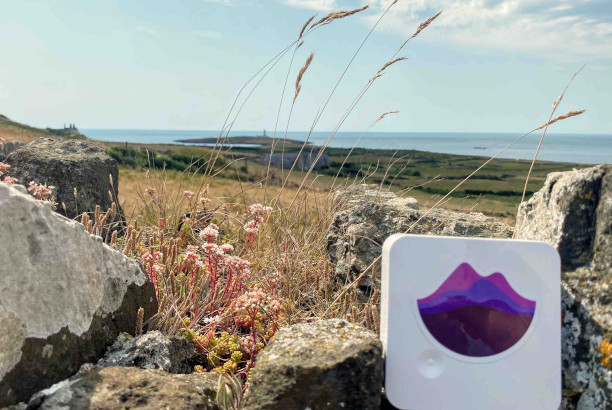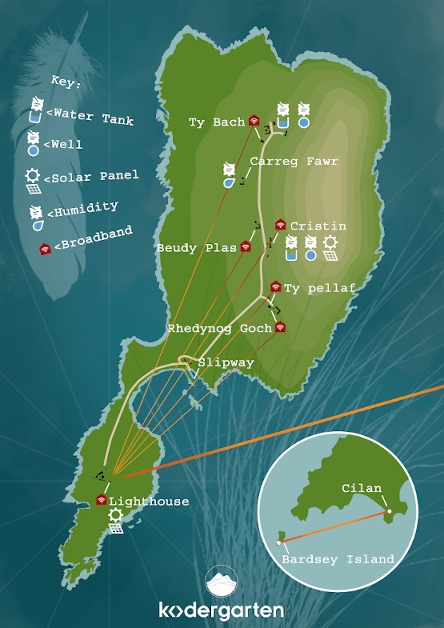<Stories/>
> Enlli - Ebb and flow
A Pen-insular paradox – Enlli pioneers forward thinking technology to complement island life



Published 17/08/2022
Paul Sandham
>Insular
- 1. Relating to or constituting an island.
- 2. Living or located on an island
- 3. Suggestive of the isolated life of an island
The word ‘Insular’ was originally used to describe living on an island, an island way of life. It is only in the last 150 years and in tandem with depopulation and migration of rural populations to the cities that it has come to take on its current meaning - narrow minded and unwilling to accept new ideas - perhaps because of how those that left perceived what they had left behind? An emigrant’s perspective? As a descendant of islanders who left their homes during the latter part of the 19th century to head to the mainland, this resonates with stories I heard from my grandparents about where their parents and grandparents had emigrated from.
However, Enlli, an island 1.9 miles off the coast of the Llŷn Peninsula in the Welsh county of Gwynedd, though remote, has cultivated new ideas throughout history and continues to do so today and in our experience having worked on connecting the islanders to Superfast Broadband, and the Internet of Things (IoT) the island is ahead of quite a lot of the mainland in terms of its use of technology.
The tech stack we created for them, is now up and running, and will, we hope, come to be an essential and reliable part of the island’s fabric. It has the capability to transform some small but essential parts of island life, such as monitoring water levels in tanks and Wells and solar panel energy generation, as well as the study of wildlife. It is a robust, low power, low cost, multilingual and multi-sensor solution that has been successfully deployed in this remote place, which does not have reliable access to standard IoT LoRaWaN services.
Please Click here, to see the full case study of what we did
Worth noting, as part of the charm of the island for visitors, is to disconnect from the Internet, it has only been made available to the islanders themselves, to preserve this tranquility.
As we began planning how to connect the islanders, and getting consent to use a small building within the lighthouse complex, the island’s most significant technological investment to date, as the location of the island hub of our broadband and IoT project, the paradox of the word “insular” was lost on us. The site, a solid, quite charming, stone shed was chosen after discussions with the islanders, quite simply the best place for us to be able to see and make a microwave link with a small part of the mainland.
As the first phase of the project comes to completion, we are finally able to take a moment to delight in the island’s past, look forward to how the project will evolve (and perhaps what will be next written in the history books!) and celebrate those that brought this modern-day technological feat into fruition.

>The ebb and flow of the island’s history
In 1820, as a result of a rapidly increasing volume of ships using the Irish Sea to move goods and people from Liverpool, Dublin, South Wales, Bristol ,Glasgow, the booming Welsh slate ports to further afield, the Atlantic and the world; Trinity House built the (still operational) 30m tall lighthouse on Ynys Enlli to guide ships along the eastern flank of the Irish Sea. The first lighting of the lamp took place on Christmas Eve 1821, just over 200 years ago.
At the time of the lighthouse construction, on the exposed southern tip of the island, there were more than 60 people living on it, by the 1880s the population had risen to over 130, by 2019 the island had a permanent population of only 4.
In a pattern repeated across so many of Britain’s inhabited islands, waves of people have ebbed away to the bright lights of the cities as work/investment/education/healthcare and living in distant inaccessible places became harder. The school closed and the cost of living on the island increased while incomes conversely plummeted.
Despite this exodus, for the last 50 years Enlli – the island of 20,000 saints - has once again become a place of pilgrimage, a sanctuary from the modern world, its broad backed flank protecting its visitors from the mainland from whence they came. The Island’s Trust has played a massive role in stopping the decline, repurposing, and renovating buildings on the island for people to come and stay in the summer months. However, Enlli has remained - in many ways - a backwater - still important for those that study migratory birds and of course the scant population that remains to farm and fish its waters, who welcome visitors.
For millennia Enlli was a place where things happened, where people met, where monks and abbots, islanders and traders were at the centre of things, an island nexus linking Ireland/Wales/Scotland/England and beyond - a place where ideas and knowledge were shared and spread, a hub. During the Roman Empire, the scholars Pliny: an author, naturalist, natural philosopher, navy and army commander; and Ptolemy: a mathematician, astronomer, astrologer, geographer, and music theorist; both saw fit to mark Enlli on their maps. Ptolemy knew it as Edri; Pliny called it Andros
Enlli was most definitely not a backwater. Some also claim that it is the Afallon of Welsh legend (Ynys Afallach - Island of Apples), the mythical island where King Arthur was taken by Myrddin (Merlin) and Taliesin to recuperate on a bed of gold, attended to by a princess and nine maidens.
Its spiritual place in the British Isles was so profound, that in the Middle Ages, if a pilgrim travelled to Enlli three times, it was equal to a pilgrimage to Jerusalem. The many churches and hostels that were dependent on this steady stream of devout Christians still stand along the coast of North Wales, testament to its importance in the Christian world.
The building of the lighthouse 200 years ago was significant in that it marked a point in time, a pivotal moment where it became more important to keep boats away from the island, to ensure that they arrived at the big ports safely with their valuable cargo intact. The delivery and installation of the first complex lens in 1821 (which cost more than 50% of the total budget of £5,247) reflected the fading of a place in a rapidly changing industrialised world.
>Fast forward to today
And here we are in 2022. Sat in our technology hub at the lighthouse complex setting up and re-connecting the island to the new shipping lanes of the internet. Methods of communication that are radically shifting human geography and commerce. Bringing in new technologies that the islanders of the 21st century can exploit in the ebb and flow of human existence in this special place - whose name by the way, means “island in the current”.
There is a lot more to do, we have at least another four sensors to install this year. We need to work with the islanders and Cyngor Gwynedd/Menter Môn to further improve the power supply at the lighthouse complex. We have more calibrations to complete, we have a solar panel sensor to improve and a nesting box sensor to put together with the team at the Bird Observatory. The initial phase is now up and running but over the next couple of years we hope to have put in place a solid technical infrastructure that will play a small but essential role in improving islander’s lives which will help to underpin economic, cultural and social regeneration, the return of Enlli to it’s historical role.
>Giving Thanks
Working on this project has been a privilege. I don’t think that we have ever worked with so many interesting and talented people. So here goes our collection of heartfelt thank yous.
It really would not have been possible to turn an idea of what might be possible into something that is up and running, without the help, time, patience, enthusiasm and faith of: the ferryman/postman/lighthouse maintenance engineer, boatbuilder, distiller and dreamer of floating docks and a revitalised Enlli – Colin; his neighbours on the island, Fisherman, farmer and stealth high-speed-network-designer Gareth, Meriel and family; Steve, Connor and Emma for all the time that they have put in to this at the Bird Observatory; Emyr, Mari and Sian from the Bardsey Island Trust; Peter from the Welsh Government and Dafydd from Menter Môn for helping to resolve the big problems that were outside of our domain; Rhian and Gwilym from Fferm Tan y Bryn; Sarn Bach for their patience and generosity; Anwen from Cyngor Gwynedd for managing the funding of this project; and Warren from far flung Chorlton for his beautiful map. And then there are the geeks: Sion the Openreach engineer; Jason from Llanidloes who had an awful lot of emails to deal with; Paul, king of the ladder and bespoke stainless steel mounting kits; our installer from Caernarfon; and last but not least from the Kodergarten corner; Bryn, Tim, Rhys the sensor maker of Dyffryn Nantlle and Rich who managed to record this beautiful sonic backdrop of bird calls, seals the land and waterscape on one of our visits. Have a listen, it will give you a small taste of the magic of the island, both past and present.